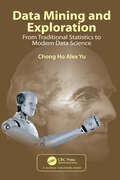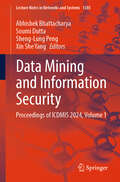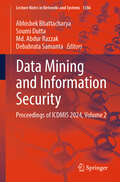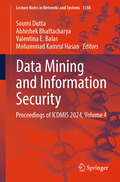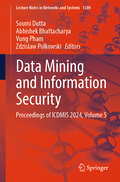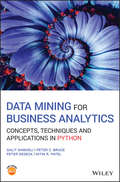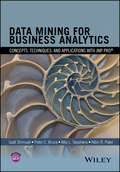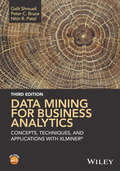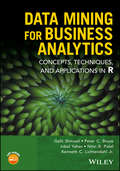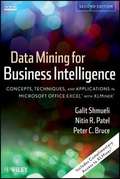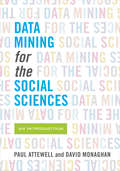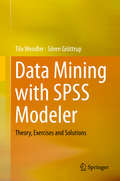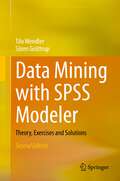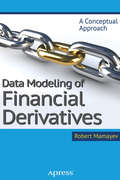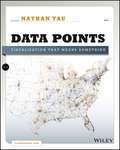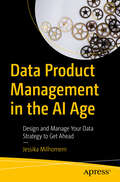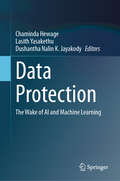- Table View
- List View
Data Mining and Business Analytics with R
by Johannes LedolterCollecting, analyzing, and extracting valuable information from a large amount of data requires easily accessible, robust, computational and analytical tools. Data Mining and Business Analytics with R utilizes the open source software R for the analysis, exploration, and simplification of large high-dimensional data sets. As a result, readers are provided with the needed guidance to model and interpret complicated data and become adept at building powerful models for prediction and classification.Highlighting both underlying concepts and practical computational skills, Data Mining and Business Analytics with R begins with coverage of standard linear regression and the importance of parsimony in statistical modeling. The book includes important topics such as penalty-based variable selection (LASSO); logistic regression; regression and classification trees; clustering; principal components and partial least squares; and the analysis of text and network data. In addition, the book presents:* A thorough discussion and extensive demonstration of the theory behind the most useful data mining tools* Illustrations of how to use the outlined concepts in real-world situations* Readily available additional data sets and related R code allowing readers to apply their own analyses to the discussed materials* Numerous exercises to help readers with computing skills and deepen their understanding of the materialData Mining and Business Analytics with R is an excellent graduate-level textbook for courses on data mining and business analytics. The book is also a valuable reference for practitioners who collect and analyze data in the fields of finance, operations management, marketing, and the information sciences.
Data Mining and Exploration: From Traditional Statistics to Modern Data Science
by Chong Ho Alex YuThis book introduces both conceptual and procedural aspects of cutting-edge data science methods, such as dynamic data visualization, artificial neural networks, ensemble methods, and text mining. There are at least two unique elements that can set the book apart from its rivals. First, most students in social sciences, engineering, and business took at least one class in introductory statistics before learning data science. However, usually these courses do not discuss the similarities and differences between traditional statistics and modern data science; as a result learners are disoriented by this seemingly drastic paradigm shift. In reaction, some traditionalists reject data science altogether while some beginning data analysts employ data mining tools as a “black box”, without a comprehensive view of the foundational differences between traditional and modern methods (e.g., dichotomous thinking vs. pattern recognition, confirmation vs. exploration, single method vs. triangulation, single sample vs. cross-validation etc.). This book delineates the transition between classical methods and data science (e.g. from p value to Log Worth, from resampling to ensemble methods, from content analysis to text mining etc.). Second, this book aims to widen the learner's horizon by covering a plethora of software tools. When a technician has a hammer, every problem seems to be a nail. By the same token, many textbooks focus on a single software package only, and consequently the learner tends to fit the problem with the tool, but not the other way around. To rectify the situation, a competent analyst should be equipped with a tool set, rather than a single tool. For example, when the analyst works with crucial data in a highly regulated industry, such as pharmaceutical and banking, commercial software modules (e.g., SAS) are indispensable. For a mid-size and small company, open-source packages such as Python would come in handy. If the research goal is to create an executive summary quickly, the logical choice is rapid model comparison. If the analyst would like to explore the data by asking what-if questions, then dynamic graphing in JMP Pro is a better option. This book uses concrete examples to explain the pros and cons of various software applications.
Data Mining and Information Security: Proceedings of ICDMIS 2024, Volume 1 (Lecture Notes in Networks and Systems #1385)
by Sheng-Lung Peng Abhishek Bhattacharya Soumi Dutta Xin She YangThis book features research papers presented at the International Conference on Data Mining and Information Security (ICDMIS 2024) held at Eminent College of Management and Technology (ECMT), West Bengal, India, during October 7–8, 2024. The book is organized in five volumes and includes high-quality research work by academicians and industrial experts in the field of computing and communication, including full-length papers, research-in-progress papers, and case studies related to all the areas of data mining, machine learning, Internet of Things (IoT), and information security.
Data Mining and Information Security: Proceedings of ICDMIS 2024, Volume 2 (Lecture Notes in Networks and Systems #1386)
by Abhishek Bhattacharya Soumi Dutta Debabrata Samanta Md Abdur RazzakThis book features research papers presented at the International Conference on Data Mining and Information Security (ICDMIS 2024) held at Eminent College of Management and Technology (ECMT), West Bengal, India, during October 7–8, 2024. The book is organized in five volumes and includes high-quality research work by academicians and industrial experts in the field of computing and communication, including full-length papers, research-in-progress papers and case studies related to all the areas of data mining, machine learning, Internet of Things (IoT) and information security.
Data Mining and Information Security: Proceedings of ICDMIS 2024, Volume 3 (Lecture Notes in Networks and Systems #1387)
by Paramartha Dutta Abhishek Bhattacharya Soumi Dutta Alvaro RochaThis book features research papers presented at the International Conference on Data Mining and Information Security (ICDMIS 2024) held at Eminent College of Management and Technology (ECMT), West Bengal, India, during October 7–8, 2024. The book is organized in five volumes and includes high-quality research work by academicians and industrial experts in the field of computing and communication, including full-length papers, research-in-progress papers and case studies related to all the areas of data mining, machine learning, Internet of Things (IoT) and information security.
Data Mining and Information Security: Proceedings of ICDMIS 2024, Volume 4 (Lecture Notes in Networks and Systems #1388)
by Valentina E. Balas Abhishek Bhattacharya Soumi Dutta Mohammad Kamrul HasanThis book features research papers presented at the International Conference on Data Mining and Information Security (ICDMIS 2024) held at Eminent College of Management and Technology (ECMT), West Bengal, India, during October 7–8, 2024. The book is organized in five volumes and includes high-quality research work by academicians and industrial experts in the field of computing and communication, including full-length papers, research-in-progress papers and case studies related to all the areas of data mining, machine learning, Internet of Things (IoT) and information security.
Data Mining and Information Security: Proceedings of ICDMIS 2024, Volume 5 (Lecture Notes in Networks and Systems #1389)
by Abhishek Bhattacharya Soumi Dutta Zdzislaw Polkowski Vung PhamThis book features research papers presented at the International Conference on Data Mining and Information Security (ICDMIS 2024) held at Eminent College of Management and Technology (ECMT), West Bengal, India, during October 7–8, 2024. The book is organized in five volumes and includes high-quality research work by academicians and industrial experts in the field of computing and communication, including full-length papers, research-in-progress papers and case studies related to all the areas of data mining, machine learning, Internet of Things (IoT) and information security.
Data Mining for Bioinformatics
by Sumeet Dua Pradeep ChowriappaCovering theory, algorithms, and methodologies, as well as data mining technologies, Data Mining for Bioinformatics provides a comprehensive discussion of data-intensive computations used in data mining with applications in bioinformatics. It supplies a broad, yet in-depth, overview of the application domains of data mining for bioinformatics to he
Data Mining for Business Analytics: Concepts, Techniques and Applications in Python
by Galit Shmueli Peter C. Bruce Nitin R. Patel Peter GedeckData Mining for Business Analytics: Concepts, Techniques, and Applications in Python presents an applied approach to data mining concepts and methods, using Python software for illustration Readers will learn how to implement a variety of popular data mining algorithms in Python (a free and open-source software) to tackle business problems and opportunities. This is the sixth version of this successful text, and the first using Python. It covers both statistical and machine learning algorithms for prediction, classification, visualization, dimension reduction, recommender systems, clustering, text mining and network analysis. It also includes: A new co-author, Peter Gedeck, who brings both experience teaching business analytics courses using Python, and expertise in the application of machine learning methods to the drug-discovery process A new section on ethical issues in data mining Updates and new material based on feedback from instructors teaching MBA, undergraduate, diploma and executive courses, and from their students More than a dozen case studies demonstrating applications for the data mining techniques described End-of-chapter exercises that help readers gauge and expand their comprehension and competency of the material presented A companion website with more than two dozen data sets, and instructor materials including exercise solutions, PowerPoint slides, and case solutions Data Mining for Business Analytics: Concepts, Techniques, and Applications in Python is an ideal textbook for graduate and upper-undergraduate level courses in data mining, predictive analytics, and business analytics. This new edition is also an excellent reference for analysts, researchers, and practitioners working with quantitative methods in the fields of business, finance, marketing, computer science, and information technology. “This book has by far the most comprehensive review of business analytics methods that I have ever seen, covering everything from classical approaches such as linear and logistic regression, through to modern methods like neural networks, bagging and boosting, and even much more business specific procedures such as social network analysis and text mining. If not the bible, it is at the least a definitive manual on the subject.” —Gareth M. James, University of Southern California and co-author (with Witten, Hastie and Tibshirani) of the best-selling book An Introduction to Statistical Learning, with Applications in R
Data Mining for Business Analytics: Concepts, Techniques, And Applications In Jmp
by Galit Shmueli Peter C. Bruce Nitin R. Patel Mia L. StephensData Mining for Business Analytics: Concepts, Techniques, and Applications with JMP Pro® presents an applied and interactive approach to data mining. Featuring hands-on applications with JMP Pro®, a statistical package from the SAS Institute, the bookuses engaging, real-world examples to build a theoretical and practical understanding of key data mining methods, especially predictive models for classification and prediction. Topics include data visualization, dimension reduction techniques, clustering, linear and logistic regression, classification and regression trees, discriminant analysis, naive Bayes, neural networks, uplift modeling, ensemble models, and time series forecasting. Data Mining for Business Analytics: Concepts, Techniques, and Applications with JMP Pro® also includes: Detailed summaries that supply an outline of key topics at the beginning of each chapter End-of-chapter examples and exercises that allow readers to expand their comprehension of the presented material Data-rich case studies to illustrate various applications of data mining techniques A companion website with over two dozen data sets, exercises and case study solutions, and slides for instructors Data Mining for Business Analytics: Concepts, Techniques, and Applications with JMP Pro® is an excellent textbook for advanced undergraduate and graduate-level courses on data mining, predictive analytics, and business analytics. The book is also a one-of-a-kind resource for data scientists, analysts, researchers, and practitioners working with analytics in the fields of management, finance, marketing, information technology, healthcare, education, and any other data-rich field. Galit Shmueli, PhD, is Distinguished Professor at National Tsing Hua University's Institute of Service Science. She has designed and instructed data mining courses since 2004 at University of Maryland, Statistics.com, Indian School of Business, and National Tsing Hua University, Taiwan. Professor Shmueli is known for her research and teaching in business analytics, with a focus on statistical and data mining methods in information systems and healthcare. She has authored over 70 journal articles, books, textbooks, and book chapters, including Data Mining for Business Analytics: Concepts, Techniques, and Applications in XLMiner®, Third Edition, also published by Wiley. Peter C. Bruce is President and Founder of the Institute for Statistics Education at www.statistics.com He has written multiple journal articles and is the developer of Resampling Stats software. He is the author of Introductory Statistics and Analytics: A Resampling Perspective and co-author of Data Mining for Business Analytics: Concepts, Techniques, and Applications in XLMiner ®, Third Edition, both published by Wiley. Mia Stephens is Academic Ambassador at JMP®, a division of SAS Institute. Prior to joining SAS, she was an adjunct professor of statistics at the University of New Hampshire and a founding member of the North Haven Group LLC, a statistical training and consulting company. She is the co-author of three other books, including Visual Six Sigma: Making Data Analysis Lean, Second Edition, also published by Wiley. Nitin R. Patel, PhD, is Chairman and cofounder of Cytel, Inc., based in Cambridge, Massachusetts. A Fellow of the American Statistical Association, Dr. Patel has also served as a Visiting Professor at the Massachusetts Institute of Technology and at Harvard University. He is a Fellow of the Computer Society of India and was a professor at the Indian Institute of Management, Ahmedabad, for 15 years. He is co-author of Data Mining for Business Analytics: Concepts, Techniques, and Applications in XLMiner®, Third Edition, also published by Wiley.
Data Mining for Business Analytics: Concepts, Techniques, And Applications In Microsoft Office Excel With Xlminer
by Galit Shmueli Peter C. Bruce Nitin R. PatelPraise for the Second Edition "...full of vivid and thought-provoking anecdotes... needs to be read by anyone with a serious interest in research and marketing." - Research Magazine "Shmueli et al. have done a wonderful job in presenting the field of data mining - a welcome addition to the literature." - ComputingReviews.com "Excellent choice for business analysts...The book is a perfect fit for its intended audience." - Keith McCormick, Consultant and Author of SPSS Statistics For Dummies, Third Edition and SPSS Statistics for Data Analysis and Visualization "...extremely well organized, clearly written and introduces all of the basic ideas quite well." - Robert L. Phillips, Professor of Professional Practice, Columbia Business School Data Mining for Business Analytics: Concepts, Techniques, and Applications in XLMiner®, Third Edition presents an applied approach to data mining and predictive analytics with clear exposition, hands-on exercises, and real-life case studies. Readers will work with all of the standard data mining methods using the Microsoft® Office Excel® add-in XLMiner® to develop predictive models and learn how to obtain business value from Big Data. Featuring updated topical coverage on text mining, social network analysis, collaborative filtering, ensemble methods, uplift modeling and more, the Third Edition also includes: Real-world examples to build a theoretical and practical understanding of key data mining methods End-of-chapter exercises that help readers better understand the presented material Data-rich case studies to illustrate various applications of data mining techniques Completely new chapters on social network analysis and text mining A companion site with additional data sets, instructors material that include solutions to exercises and case studies, and Microsoft PowerPoint® slides Free 140-day license to use XLMiner for Education software Data Mining for Business Analytics: Concepts, Techniques, and Applications in XLMiner®, Third Edition is an ideal textbook for upper-undergraduate and graduate-level courses as well as professional programs on data mining, predictive modeling, and Big Data analytics. The new edition is also a unique reference for analysts, researchers, and practitioners working with predictive analytics in the fields of business, finance, marketing, computer science, and information technology.
Data Mining for Business Analytics: Concepts, Techniques, And Applications In R
by Galit Shmueli Peter C. Bruce Nitin R. Patel Inbal Yahav Kenneth C. Lichtendahl Jr.Data Mining for Business Analytics: Concepts, Techniques, and Applications in R presents an applied approach to data mining concepts and methods, using R software for illustration Readers will learn how to implement a variety of popular data mining algorithms in R (a free and open-source software) to tackle business problems and opportunities. This is the fifth version of this successful text, and the first using R. It covers both statistical and machine learning algorithms for prediction, classification, visualization, dimension reduction, recommender systems, clustering, text mining and network analysis. It also includes: • Two new co-authors, Inbal Yahav and Casey Lichtendahl, who bring both expertise teaching business analytics courses using R, and data mining consulting experience in business and government • Updates and new material based on feedback from instructors teaching MBA, undergraduate, diploma and executive courses, and from their students • More than a dozen case studies demonstrating applications for the data mining techniques described • End-of-chapter exercises that help readers gauge and expand their comprehension and competency of the material presented • A companion website with more than two dozen data sets, and instructor materials including exercise solutions, PowerPoint slides, and case solutions Data Mining for Business Analytics: Concepts, Techniques, and Applications in R is an ideal textbook for graduate and upper-undergraduate level courses in data mining, predictive analytics, and business analytics. This new edition is also an excellent reference for analysts, researchers, and practitioners working with quantitative methods in the fields of business, finance, marketing, computer science, and information technology. “ This book has by far the most comprehensive review of business analytics methods that I have ever seen, covering everything from classical approaches such as linear and logistic regression, through to modern methods like neural networks, bagging and boosting, and even much more business specific procedures such as social network analysis and text mining. If not the bible, it is at the least a definitive manual on the subject.” Gareth M. James, University of Southern California and co-author (with Witten, Hastie and Tibshirani) of the best-selling book An Introduction to Statistical Learning, with Applications in R Galit Shmueli, PhD, is Distinguished Professor at National Tsing Hua University’s Institute of Service Science. She has designed and instructed data mining courses since 2004 at University of Maryland, Statistics.com, Indian School of Business, and National Tsing Hua University, Taiwan. Professor Shmueli is known for her research and teaching in business analytics, with a focus on statistical and data mining methods in information systems and healthcare. She has authored over 70 publications including books. Peter C. Bruce is President and Founder of the Institute for Statistics Education at Statistics.com. He has written multiple journal articles and is the developer of Resampling Stats software. He is the author of Introductory Statistics and Analytics: A Resampling Perspective (Wiley) and co-author of Practical Statistics for Data Scientists: 50 Essential Concepts (O’Reilly). Inbal Yahav, PhD, is Professor at the Graduate School of Business Administration at Bar-Ilan University, Israel. She teaches courses in social network analysis, advanced research methods, and software quality assurance. Dr. Yahav received her PhD in Operations Research and Data Mining from the University of Maryland, College Park. Nitin R. Patel, PhD, is Chairman and cofounder of Cytel, Inc., based in Cambridge, Massachusetts. A Fellow of the American St
Data Mining for Business Analytics: Concepts, Techniques, and Applications with XLMiner
by Galit Shmueli Peter C. Bruce Nitin R. PatelData Mining for Business Analytics: Concepts, Techniques, and Applications in XLMiner®, Third Edition presents an applied approach to data mining and predictive analytics with clear exposition, hands-on exercises, and real-life case studies. Readers will work with all of the standard data mining methods using the Microsoft® Office Excel® add-in XLMiner® to develop predictive models and learn how to obtain business value from Big Data. Featuring updated topical coverage on text mining, social network analysis, collaborative filtering, ensemble methods, uplift modeling and more, the Third Edition also includes: Real-world examples to build a theoretical and practical understanding of key data mining methods End-of-chapter exercises that help readers better understand the presented material Data-rich case studies to illustrate various applications of data mining techniques Completely new chapters on social network analysis and text mining A companion site with additional data sets, instructors material that include solutions to exercises and case studies, and Microsoft PowerPoint® slides https://www.dataminingbook.com Free 140-day license to use XLMiner for Education software Data Mining for Business Analytics: Concepts, Techniques, and Applications in XLMiner®, Third Edition is an ideal textbook for upper-undergraduate and graduate-level courses as well as professional programs on data mining, predictive modeling, and Big Data analytics. The new edition is also a unique reference for analysts, researchers, and practitioners working with predictive analytics in the fields of business, finance, marketing, computer science, and information technology. Praise for the Second Edition "…full of vivid and thought-provoking anecdotes... needs to be read by anyone with a serious interest in research and marketing."– Research Magazine "Shmueli et al. have done a wonderful job in presenting the field of data mining - a welcome addition to the literature." – ComputingReviews.com"Excellent choice for business analysts...The book is a perfect fit for its intended audience." – Keith McCormick, Consultant and Author of SPSS Statistics For Dummies, Third Edition and SPSS Statistics for Data Analysis and Visualization Galit Shmueli, PhD, is Distinguished Professor at National Tsing Hua University’s Institute of Service Science. She has designed and instructed data mining courses since 2004 at University of Maryland, Statistics.com, The Indian School of Business, and National Tsing Hua University, Taiwan. Professor Shmueli is known for her research and teaching in business analytics, with a focus on statistical and data mining methods in information systems and healthcare. She has authored over 70 journal articles, books, textbooks and book chapters. Peter C. Bruce is President and Founder of the Institute for Statistics Education at www.statistics.com. He has written multiple journal articles and is the developer of Resampling Stats software. He is the author of Introductory Statistics and Analytics: A Resampling Perspective, also published by Wiley. Nitin R. Patel, PhD, is Chairman and cofounder of Cytel, Inc., based in Cambridge, Massachusetts. A Fellow of the American Statistical Association, Dr. Patel has also served as a Visiting Professor at the Massachusetts Institute of Technology and at Harvard University. He is a Fellow of the Computer Society of India and was a professor at the Indian Institute of Management, Ahmedabad for 15 years.
Data Mining for Business Intelligence
by Galit Shmueli Peter C. Bruce Nitin R. PatelPraise for the First Edition" full of vivid and thought-provoking anecdotes needs to be read by anyone with a serious interest in research and marketing."--Research magazine"Shmueli et al. have done a wonderful job in presenting the field of data mining a welcome addition to the literature."--computingreviews.comIncorporating a new focus on data visualization and time series forecasting, Data Mining for Business Intelligence, Second Edition continues to supply insightful, detailed guidance on fundamental data mining techniques. This new edition guides readers through the use of the Microsoft Office Excel add-in XLMiner for developing predictive models and techniques for describing and finding patterns in data.From clustering customers into market segments and finding the characteristics of frequent flyers to learning what items are purchased with other items, the authors use interesting, real-world examples to build a theoretical and practical understanding of key data mining methods, including classification, prediction, and affinity analysis as well as data reduction, exploration, and visualization.The Second Edition now features:Three new chapters on time series forecasting, introducing popular business forecasting methods including moving average, exponential smoothing methods; regression-based models; and topics such as explanatory vs. predictive modeling, two-level models, and ensemblesA revised chapter on data visualization that now features interactive visualization principles and added assignments that demonstrate interactive visualization in practiceSeparate chapters that each treat k-nearest neighbors and Naïve Bayes methodsSummaries at the start of each chapter that supply an outline of key topicsThe book includes access to XLMiner, allowing readers to work hands-on with the provided data. Throughout the book, applications of the discussed topics focus on the business problem as motivation and avoid unnecessary statistical theory. Each chapter concludes with exercises that allow readers to assess their comprehension of the presented material. The final chapter includes a set of cases that require use of the different data mining techniques, and a related Web site features data sets, exercise solutions, PowerPoint slides, and case solutions.Data Mining for Business Intelligence, Second Edition is an excellent book for courses on data mining, forecasting, and decision support systems at the upper-undergraduate and graduate levels. It is also a one-of-a-kind resource for analysts, researchers, and practitioners working with quantitative methods in the fields of business, finance, marketing, computer science, and information technology.
Data Mining for the Social Sciences
by David Monaghan Paul AttewellWe live in a world of big data: the amount of information collected on human behavior each day is staggering, and exponentially greater than at any time in the past. Additionally, powerful algorithms are capable of churning through seas of data to uncover patterns. Providing a simple and accessible introduction to data mining, Paul Attewell and David B. Monaghan discuss how data mining substantially differs from conventional statistical modeling familiar to most social scientists. The authors also empower social scientists to tap into these new resources and incorporate data mining methodologies in their analytical toolkits. Data Mining for the Social Sciences demystifies the process by describing the diverse set of techniques available, discussing the strengths and weaknesses of various approaches, and giving practical demonstrations of how to carry out analyses using tools in various statistical software packages.
Data Mining with SPSS Modeler: Theory, Exercises and Solutions
by Tilo Wendler Sören GröttrupIntroducingthe IBM SPSS Modeler, this book guides readers through data mining processesand presents relevant statistical methods. There is a special focus onstep-by-step tutorials and well-documented examples that help demystify complexmathematical algorithms and computer programs. The variety of exercises andsolutions as well as an accompanying website with data sets and SPSS Modeler streams are particularly valuable. Whileintended for students, the simplicity of the Modeler makes the book useful foranyone wishing to learn about basic and more advanced data mining, and put thisknowledge into practice.
Data Mining with SPSS Modeler: Theory, Exercises and Solutions
by Tilo Wendler Sören GröttrupNow in its second edition, this textbook introduces readers to the IBM SPSS Modeler and guides them through data mining processes and relevant statistical methods. Focusing on step-by-step tutorials and well-documented examples that help demystify complex mathematical algorithms and computer programs, it also features a variety of exercises and solutions, as well as an accompanying website with data sets and SPSS Modeler streams. While intended for students, the simplicity of the Modeler makes the book useful for anyone wishing to learn about basic and more advanced data mining, and put this knowledge into practice. This revised and updated second edition includes a new chapter on imbalanced data and resampling techniques as well as an extensive case study on the cross-industry standard process for data mining.
Data Mining: A Tutorial-Based Primer, Second Edition (Chapman & Hall/CRC Data Mining and Knowledge Discovery Series)
by Richard J. Roiger"Dr. Roiger does an excellent job of describing in step by step detail formulae involved in various data mining algorithms, along with illustrations. In addition, his tutorials in Weka software provide excellent grounding for students in comprehending the underpinnings of Machine Learning as applied to Data Mining. The inclusion of?RapidMiner software tutorials and examples in the book is also a definite plus since it is one of the most popular Data Mining software platforms in use today." --Robert Hughes, Golden Gate University, San Francisco, CA, USA Data Mining: A Tutorial-Based Primer, Second Edition provides a comprehensive introduction to data mining with a focus on model building and testing, as well as on interpreting and validating results. The text guides students to understand how data mining can be employed to solve real problems and recognize whether a data mining solution is a feasible alternative for a specific problem. Fundamental data mining strategies, techniques, and evaluation methods are presented and implemented with the help of two well-known software tools. Several new topics have been added to the second edition including an introduction to Big Data and data analytics, ROC curves, Pareto lift charts, methods for handling large-sized, streaming and imbalanced data, support vector machines, and extended coverage of textual data mining. The second edition contains tutorials for attribute selection, dealing with imbalanced data, outlier analysis, time series analysis, mining textual data, and more. The text provides in-depth coverage of RapidMiner Studio and Weka’s Explorer interface. Both software tools are used for stepping students through the tutorials depicting the knowledge discovery process. This allows the reader maximum flexibility for their hands-on data mining experience.
Data Mining: Technologies, Techniques, Tools, and Trends
by Bhavani ThuraisinghamFocusing on a data-centric perspective, this book provides a complete overview of data mining: its uses, methods, current technologies, commercial products, and future challenges.Three parts divide Data Mining:Part I describes technologies for data mining - database systems, warehousing, machine learning, visualization, decision sup
Data Mining: Theories, Algorithms, and Examples (Human Factors And Ergonomics Ser.)
by Nong YeNew technologies have enabled us to collect massive amounts of data in many fields. However, our pace of discovering useful information and knowledge from these data falls far behind our pace of collecting the data. Data Mining: Theories, Algorithms, and Examples introduces and explains a comprehensive set of data mining algorithms from various dat
Data Modeling for the Sciences: Applications, Basics, Computations
by Steve Pressé Ioannis SgouralisWith the increasing prevalence of big data and sparse data, and rapidly growing data-centric approaches to scientific research, students must develop effective data analysis skills at an early stage of their academic careers. This detailed guide to data modeling in the sciences is ideal for students and researchers keen to develop their understanding of probabilistic data modeling beyond the basics of p-values and fitting residuals. The textbook begins with basic probabilistic concepts, models of dynamical systems and likelihoods are then presented to build the foundation for Bayesian inference, Monte Carlo samplers and filtering. Modeling paradigms are then seamlessly developed, including mixture models, regression models, hidden Markov models, state-space models and Kalman filtering, continuous time processes and uniformization. The text is self-contained and includes practical examples and numerous exercises. This would be an excellent resource for courses on data analysis within the natural sciences, or as a reference text for self-study.
Data Modeling of Financial Derivatives: A Conceptual Approach
by Robert MamayevWritten in plain English and based on successful client engagements, Data Modeling of Financial Derivatives: A Conceptual Approach introduces new and veteran data modelers, financial analysts, and IT professionals to the fascinating world of financial derivatives. Covering futures, forwards, options, swaps, and forward rate agreements, finance and modeling expert Robert Mamayev shows you step-by-step how to structure and describe financial data using advanced data modeling techniques. The book introduces IT professionals, in particular, to various financial and data modeling concepts that they may not have seen before, giving them greater proficiency in the financial language of derivatives--and greater ability to communicate with financial analysts without fear or hesitation. Such knowledge will be especially useful to those looking to pick up the necessary skills to become productive right away working in the financial sector. Financial analysts reading this book will come to grips with various data modeling concepts and therefore be in better position to explain the underlying business to their IT audience. Data Modeling of Financial Derivatives--which presumes no advanced knowledge of derivatives or data modeling--will help you: Learn the best entity-relationship modeling method out there--Barker's CASE methodology--and its application in the financial industry Understand how to identify and creatively reuse data modeling patterns Gain an understanding of financial derivatives and their various applications Learn how to model derivatives contracts and understand the reasoning behind certain design decisions Resolve derivatives data modeling complexities parsimoniously so that your clients can understand them intuitively Packed with numerous examples, diagrams, and techniques, this book will enable you to recognize the various design patterns that you are most likely to encounter in your professional career and apply them successfully in practice. Anyone working with financial models will find it an invaluable tool and career booster. What you'll learn You will learn how to: Recognize and identify financial derivatives Reuse data modeling patterns and apply them to create something new Data model simple and complex options Data model SWAPS Data model futures and forward contracts Who this book is for Data modelers, financial analysts, IT professionals, and anyone with an interest in data modeling and business analysis. Table of Contents Introduction Notation Financial Contracts Primer Modeling Forward Contracts Modeling Futures Contracts Modeling Options Advanced Options Modeling - Designing Trading Strategies Swaps and Forward Rate Agreements (FRAs) Finishing Thoughts
Data Points
by Nathan YauA fresh look at visualization from the author of Visualize ThisWhether it's statistical charts, geographic maps, or the snappy graphical statistics you see on your favorite news sites, the art of data graphics or visualization is fast becoming a movement of its own. In Data Points: Visualization That Means Something, author Nathan Yau presents an intriguing complement to his bestseller Visualize This, this time focusing on the graphics side of data analysis. Using examples from art, design, business, statistics, cartography, and online media, he explores both standard-and not so standard-concepts and ideas about illustrating data. Shares intriguing ideas from Nathan Yau, author of Visualize This and creator of flowingdata.com, with over 66,000 subscribersFocuses on visualization, data graphics that help viewers see trends and patterns they might not otherwise see in a tableIncludes examples from the author's own illustrations, as well as from professionals in statistics, art, design, business, computer science, cartography, and moreExamines standard rules across all visualization applications, then explores when and where you can break those rulesCreate visualizations that register at all levels, with Data Points: Visualization That Means Something.
Data Product Management in the AI Age: Design and Manage Your Data Strategy to Get Ahead
by Jessika Milhomem&“An outstanding companion for any data professional seeking to deepen their expertise and grow in the field of Data Product Management.&” (Eduardo Juremeira, Data Engineering Manager, Adyen) &“This book is a valuable resource for data professionals, offering clear concepts and practical tools.&” (Luis Oliveira, Analytics Engineering Tech Manager, Nubank) A practical guide to mastering data product management—bridging strategy, architecture, and execution for the AI era. We have firmly entered the age of artificial intelligence (AI). Data, the backbone of this technology, is more crucial than ever. If the algorithm is the brain, data is the content that feeds it. This book argues that to succeed in this era, organizations should adopt a holistic approach to data—one that uses product management principles to inform how data is sourced, designed, managed, maintained, optimized, and leveraged. This book is divided into two sections, moving from fundamentals to practical applications. In the first part, you&’ll learn about the concepts that underlie product theory, the data architecture journey, and the essential knowledge needed to manage data products. The second part focuses on putting everything into practice, with particular attention to designing solutions, ongoing maintenance, and optimization. Additionally, the book introduces the Golden Data Platform and the Data Product Management Canvas, important tools and frameworks coined by author Jessika Milhomem. These resources will help you begin transforming your organization&’s data strategy, empowering you to stay ahead of the competition and thrive in the AI age. What You Will Learn Explore the evolution of data architecture and strategies Understand the fundamentals of data product management Differentiate between Data Product and Data as a Product Know what the Golden Data Platform is and how to use it Utilize the Data Product Management Canvas effectively Reorient your data strategy with product management principles Examine the concepts of products and data architecture evolution in relation to leadership Evaluate how to solve data architecture without bias by technology Design and implement Data as a Product and Data Products through a project Maintain and enhance Data Products once launched Who </stron
Data Protection: The Wake of AI and Machine Learning
by Dushantha Nalin K. Jayakody Chaminda Hewage Lasith YasakethuThis book provides a thorough and unique overview of the challenges, opportunities and solutions related with data protection in the age of AI and ML technologies. It investigates the interface of data protection and new technologies, emphasising the growing need to safeguard personal and confidential data from unauthorised access and change. The authors emphasize the crucial need of strong data protection regulations, focusing on the consequences of AI and ML breakthroughs for privacy and individual rights. This book emphasizes the multifarious aspect of data protection, which goes beyond technological solutions to include ethical, legislative and societal factors. This book explores into the complexity of data protection in the age of AI and ML. It investigates how massive volumes of personal and sensitive data are utilized to train and develop AI models, demanding novel privacy-preserving strategies such as anonymization, differential privacy and federated learning. The duties and responsibilities of engineers, policy makers and ethicists in minimizing algorithmic bias and ensuring ethical AI use are carefully defined. Key developments, such as the influence of the European Union's General Data Protection Regulation (GDPR) and the EU AI Act on data protection procedures, are reviewed critically. This investigation focusses not only on the tactics used, but also on the problems and successes in creating a secure and ethical AI ecosystem. This book provides a comprehensive overview of the efforts to integrate data protection into AI innovation, including valuable perspectives on the effectiveness of these measures and the ongoing adjustments required to address the fluid nature of privacy concerns. This book is a helpful resource for upper-undergraduate and graduate computer science students, as well as others interested in cybersecurity and data protection. Researchers in AI, ML, and data privacy as well as data protection officers, politicians, lawmakers and decision-makers will find this book useful as a reference.

